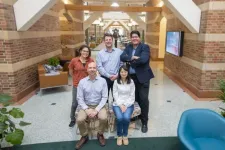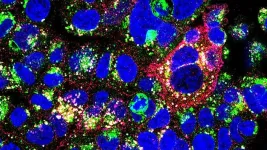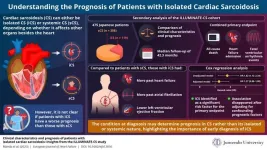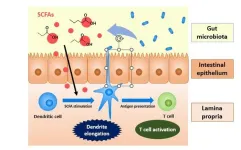(Press-News.org) WASHINGTON – The Society of Neuroscience (SfN) will honor leading researchers whose
pioneering work has transformed neuroscience — including the understanding of the visual
system, addiction, synaptic plasticity, and learning and memory — with this year’s Outstanding
Career and Research Achievement Awards. The awards will be presented during Neuroscience
2023, SfN’s annual meeting.
“The Society is honored to recognize this year’s awardees, whose groundbreaking work has
transformed our understanding of plasticity in the mammalian brain — from the synaptic level
to the systems level — as well as uncovered neuronal mechanisms behind addiction,
compulsion, and depression,” SfN President Oswald Steward said. “These neuroscientists’
innovative approaches and paradigm‐shifting findings have overturned previous doctrine,
revolutionized our understanding of the field, and provided hope for novel therapeutic
approaches.”
Ralph W. Gerard Prize in Neuroscience: Michael Stryker
The Ralph W. Gerard Prize in Neuroscience — the highest honor bestowed by SfN — recognizes
an outstanding scientist who has made significant contributions to neuroscience throughout
their career. The prize is named for the revered neuroscientist Dr. Ralph W. Gerard who helped
establish the Society for Neuroscience and served as its honorary president. The award includes
a $30,000 prize and travel to SfN’s annual meeting.
Michael Stryker, a neuroscientist and the chair of physiology at the University of California San
Francisco, profoundly transformed the understanding of how the visual system functions,
develops, and changes based on sensory experience. Among his many discoveries are that
orientation selectivity of neurons in the visual cortex develops even with limited or no visual
experience, that spontaneous retinal activity is critical to normal development, and that
inhibitory circuits play a central role in regulating the critical period, a finding that helps explain
some neurodevelopmental disorders and that points to interventions that can reinstate
plasticity in mature circuits. His work changed the terms of the nature‐nurture debate by
showing that common mechanisms underlie both innate and experience‐dependent
development. He distinguished juvenile plasticity from slower, qualitatively different adult
plasticity and demonstrated manipulations that enhance plasticity in the visual cortex and
create a second “critical period” during which synaptic changes are enabled. He also pioneered
the use of ferrets and mice as model systems for the study of the mammalian visual system,
each of which has initiated new areas of research now conducted by many laboratories.
Stryker’s classic studies are in every major neuroscience textbook and are fundamental to the
field’s common understanding of how experience influences cortical development and
plasticity.
Julius Axelrod Prize: Mark Bear and Raymond Dingledine
The Julius Axelrod Prize honors scientists with distinguished achievements in the broad field of
neuropharmacology or a related area and exemplary efforts in mentoring young scientists. The
award is endowed by the Eli Lilly and Company Foundation and includes a $30,000 prize and
travel to SfN’s annual meeting.
Mark Bear, a professor of neuroscience at Massachusetts Institute of Technology,
fundamentally advanced our understanding of experience‐dependent plasticity in the
mammalian brain. He and his students showed that NMDA receptors trigger long‐term
depression (LTD) as well as long‐term potentiation (LTP) in the cortex, that the properties of
LTD and LTP are themselves “metaplastic” and depend on the recent history of cortical activity
and that these bidirectional synaptic modifications and metaplasticity are essential for
development of the visual cortex. His lab’s demonstration of LTD in the hippocampus was
paradigm‐shifting, opening the door to numerous studies of the fundamental molecular
mechanisms of synaptic modification. Their finding that LTD is impacted in several
developmental disorders led to the insight that excess protein synthesis downstream of the
glutamate receptor mGlu5 is a core driver of the synaptic, circuit, and behavioral dysfunction
seen in Fragile X Syndrome, the most common form of inherited intellectual disability and a
leading monogenic cause of autism. This work ushered in a sea change in how this and other
developmental brain disorders are viewed medically and has led to numerous clinical trials in
both Fragile X and autism. Additionally, Bear is an extraordinary mentor, with 18 of his 35
former postdoctoral researchers and 11 of his former PhD students now in tenure track
positions. He is known for his positivity, optimism, and steadfast enthusiasm for science — even
in the face of the challenges that research and funding present — and through his mentorship
he passes these essential traits on to the next generation of scientists.
Raymond Dingledine, a professor of pharmacology at Emory University, is a pioneer in the
pharmacology of glutamate receptors. He demonstrated that glycine, in addition to glutamate,
is required for NMDA receptor activation and coined the term “coagonists” to describe the
novel relationship between the two neurotransmitters. He also revealed multiple mechanisms
by which properties of postsynaptic glutamatergic receptors are regulated, including the
determinants of their calcium permeability. Dingledine has frequently adapted and
incorporated new techniques and technologies to address key questions. Early in his career he
helped develop electrophysiological recordings from thin hippocampal slices, and his lab was
the first to express NMDA receptors in frog oocytes for quantitative pharmacology analysis. His
recent work is focused on seizure‐induced neuroinflammation, which has strong potential for
clinical translation. He and his colleagues demonstrated a profound role for EP2 receptor
activation by prostaglandin E2 in neuropathologies caused by upregulation of cyclooxygenase‐
2. He cofounded the Emory Chemical Biology Discovery Center as well as two biotechnology
companies working to develop treatments for cerebral ischemia and neuroinflammation. In
addition to his rigorous scientific work, Dingledine has been fortunate to mentor outstanding
students and postdoctoral researchers. He has trained over 60 scientists, most of whom have
gone on to highly successful careers in academia, industry, or government. His trainees are
inspired by the collaborative atmosphere he fosters and his commitment to applying
quantitative, measurable, and objective criteria to describe results and analyze scientific data.
Jacob P. Waletzky Award: Hedy Kober
The Jacob P. Waletzky award recognizes an early career scientist (within fifteen years of their
PhD or MD degree) whose independent research has led to significant conceptual and empirical
contributions to the understanding of drug addiction and who plans to continue to make
significant contributions to addiction research and treatment. The award is endowed by The
Waletzky Family and The Waletzky Award Prize Fund and includes a $30,000 prize and travel to
SfN’s annual meeting.
Hedy Kober, a cognitive neuroscientist and clinical psychologist at Yale University, has made
transformative contributions to the addiction field in her studies on drug craving, treatment,
and relapse. Her lab uses state‐of‐the art cognitive neuroscience and neuroimaging approaches
to address central questions on emotion regulation in addiction, and the neural mechanisms
underlying treatments. She performed a large meta‐analysis that resolved a fundamental
question in the field by showing that craving predicts drug use and relapse across drug types
and measurement types, demonstrating that craving is a useful measure of treatment
outcomes. Her research also revealed substantial similarities in the brain’s response to drug
cues and non‐drug rewards, and in the neural mechanisms used to regulate craving and other
emotions. Further, Kober created the first brain‐based biomarker of drug craving, using it to
classify users of drugs from non‐users with high accuracy — truly innovative work with
implications for both diagnosis and treatment of addictions. Kober advanced our understanding
in how treatments for addictions work by creating a novel task that demonstrated that
cognitive‐behavioral and mindfulness‐based strategies rely on different neural mechanisms.
She was the first to identify the promise of modeling treatment components using fMRI to
understand their neural mechanisms and is helping create digital platforms to make treatments
more widely accessible. Kober’s research holds the promise of leading to additional major
advances in how clinical addiction is understood, diagnosed, and treated.
Swartz Prize for Theoretical and Computational Neuroscience: Misha Tsodyks
The Swartz Prize for Theoretical and Computational Neuroscience is given to an individual
whose activities have produced a significant cumulative contribution to theoretical models or
computational methods in neuroscience or who has made a particularly noteworthy recent
advance in theoretical or computational neuroscience. The award is endowed by the Swartz
Foundation and includes a $30,000 prize and travel to SfN’s annual meeting.
Misha Tsodyks, a professor of neuroscience at the Weizmann Institute of Science in Israel and
Institute for Advanced Study in Princeton, USA has profoundly impacted the quantitative
understanding of learning and memory, from the synapse to the systems levels. His work
revealed the importance of sparsity in neural networks, mechanisms of short‐term synaptic
plasticity, and insights into the storage and retrieval of information from long‐term memory. He
has propelled the field forward, publishing many ground‐breaking papers that overturned the
dominant thinking of the time. Multiple models he proposed are now standard in the field.
Early in his career, Tsodyks created a model of associative memory using sparse encoding of
information and predicted improvements in neural networks by increasing storage capacity and
reducing interference effects. Tsodyks then proposed how continuous attractor networks for
place cells are critical for the emergence of hippocampal spatial maps. Along with Henry
Markram, Tsodyks developed the now leading theoretical model of short‐term plasticity,
showing that synaptic facilitation could underly working memory. This framework has been
widely used in studies of the effects of short‐term plasticity on information processing in the
brain. More recently, Tsodyks developed a mathematical theory of memory, predicting that the
number of items presented and subsequently recalled depends on specific interactions
between items. His theory aligns beautifully with the results of a large study of human memory.
Throughout his career, Tsodyks has shown an impressive ability to build strikingly simple and
elegant models that have significantly shaped the field of computational neuroscience.
Peter Seeburg Integrative Neuroscience Prize: Christian Lüscher and Eric Nestler
The Peter Seeburg Integrative Neuroscience Prize, endowed by the Schaller‐Nikolich
Foundation, honors original and groundbreaking achievements in neuroscience. Named after
Peter H. Seeburg, a German neuroscientist and pioneer in molecular neurobiology, the prize
recognizes outstanding advances in the understanding of executive brain functions and
cognitive processes. The award includes a $100,000 prize and travel to SfN’s annual meeting.
Christian Lüscher, a neuroscience professor at the University of Geneva, has advanced the
knowledge of the circuit mechanisms underlying psychiatric illnesses and drug addiction and
established direct links between altered synaptic transmission and addictive behaviors. His
work classifying addictive drugs based on the cellular mechanisms by which they increase
dopamine is groundbreaking. He was the first to provide proof of principle that reversal of drugevoked
synaptic plasticity can normalize behavior. This work is a key experiment in optogenetic
literature and is often referenced by the scientific community. Lüscher also established a
compelling circuit model of drug addiction, which he used to create an electric brain stimulation
protocol that successfully treated addictive behaviors in mice. This research has great
translational potential for treating human disorders such as obsessive‐compulsive disorder and
depression. Using a novel addiction model based on the optogenetic self‐stimulation of
dopaminergic neurons, he identified synaptic changes driving the behavior in compulsive
individuals. This clever work provides both an answer and a mechanism for a central question in
addiction research. Lüscher’s systematic and pioneering approach has uncovered the neuronal
mechanisms of compulsion, the defining symptom of several psychiatric diseases.
Eric Nestler, a professor of neuroscience at the Icahn School of Medicine at Mount Sinai, has
pioneered the understanding of the molecular, cellular, and physiological changes in the brain
caused by drugs of abuse. Through the pioneering use of viral‐mediated gene transfer and
inducible mutant mice, he experimentally altered the activity of genes within reward pathways
and studied the consequences on the functioning of neural circuits and their behavioral
outputs. Nestler was the first to demonstrate how common molecular mechanisms underlie
different types of addictions. He also developed a well‐validated mouse model of depression
and used it to establish a critical role for the brain’s reward circuits in depression, a discovery
since validated in humans. He used gene and chromatin analyses to discover numerous
proteins that mediate either susceptibility or resistance to depression in animals, work that has
transformed treatment efforts. By uniquely integrated molecular and cellular findings within a
circuit and systems context, Nestler has transformed the field and made foundational
contributions to establishing a molecular basis for drug addiction and depression.
SfN Service Award: David H. Cohen
As a special SfN Service Award for 2023, SfN is pleased to recognize David H. Cohen, for more
than 50 years of volunteer service to SfN, including as SfN president from 1981 to 1982. “On
behalf of SfN, I am delighted to present this award to Dr. Cohen to express the Society’s
gratitude for his five decades of contributions as a volunteer leader,” said Oswald Steward, SfN
president. “His work as a leader, mentor, and advocate for neuroscience helped shape the
Society into the organization it is today.”
Cohen’s academic journey started in mathematics at Harvard, continued with psychology at
UCLA, and from there he joined the emerging field of neuroscience. His research focused on
creating a vertebrate model system to identify synaptic physiological mechanisms of a simple
form of learning (classical conditioning) using pigeons. This involved pairing a conditioned
stimulus (CS) with mild shock (UCS) and measuring increases in heart rate, which are a measure
of the overall autonomic response. This work identified the amygdala as a point of
convergence of signals induced by CS and UCS and the likely site of learning. This work
heralded later studies by many others that identified the amygdala as a key node in fear
conditioning. Cohen joined the faculty at the University of Virginia in 1968, and his engagement
with the Society began as SfN was founded. He founded the SfN Virginia chapter in 1970 and
joined the Committee on Chapters in 1971. He was elected SfN secretary in 1975 and played a
key role in early advocacy and international outreach. As SfN president from 1981 to 1982, he
focused on strategic goals of the Society and on promoting neuroscience as a developing field.
After his term as president and on SfN Council, he worked to help build the long‐term financial
stability of the Society. He served on the Long‐Range Planning Committee in the early 1980s,
joined the Finance Committee in 2000 and served as the founding chair of the SfN Investment
Committee beginning in 2002. His astute leadership guided the foundation of the financial
strategy that brought SfN through the COVID‐19 pandemic. He served on the Real Estate
Committee from 2004 to 2006 and played a key role in SfN’s decision to buy a building in
Washington, D.C. Since then, he has remained a longtime mentor and advisor to many SfN
leaders and staff. He continues to serve as an active member of the Investment Committee.
Beyond his volunteer leadership in the Society, Cohen’s many contributions to neuroscience
and higher education span his long career. After the University of Virginia, he went to SUNY
Stony Brook, where he created a new Department of Neurobiology and Behavior. In 1986 he
moved into university administration, becoming vice president for research and dean of the
graduate school at Northwestern University and eventually becoming provost. In 1995 he
moved to Columbia University, where he was vice president and dean of the faculty of Arts and
Sciences until retiring from that role in 2003. He has served other societies, most notably as
president for the Association of Neuroscience Departments and Programs and chair of the
Association of American Medical Colleges.
###
The Society for Neuroscience (SfN) is an organization of nearly 35,000 basic scientists and
clinicians who study the brain and the nervous system.
END
Society for Neuroscience 2023 Outstanding Career and Research Achievements
2023-10-30
ELSE PRESS RELEASES FROM THIS DATE:
Society for Neuroscience 2023 Early Career Scientists’ Achievements and Research Awards
2023-10-30
WASHINGTON – The Society for Neuroscience (SfN) will honor eight early-career researchers whose work is transforming our understanding of the neural dynamics of touch sensation, spatial navigation, memory circuits, and more. The awards will be presented during Neuroscience 2023, SfN's annual meeting. “This year’s Early Career Awardees are pushing the boundaries of neuroscience by combining cutting-edge methods in machine learning, microscopy, genetics, biophysics, and beyond,” said SfN President Oswald ...
Society for Neuroscience 2023 Education and Outreach Awards
2023-10-30
WASHINGTON – The Society for Neuroscience (SfN) will present five neuroscientists with this year’s Science Education and Outreach Awards, comprising the Award for Education in Neuroscience, the Science Educator Award, and the Next Generation Awards. The awards will be presented during SfN’s annual meeting, Neuroscience 2023.
“The Society is honored to recognize this creative group of neuroscientists working to educate the public about science and combat misinformation,” SfN President Oswald Steward, said. “Their innovative approaches — including games and viral social media videos — inspire not just the next generation of neuroscientists, ...
A sustainable alternative to air conditioning
2023-10-30
As the planet gets hotter, the need for cool living environments is becoming more urgent. But air conditioning is a major contributor to global warming since units use potent greenhouse gases and lots of energy.
Now, researchers from McGill University, UCLA and Princeton have found in a new study an inexpensive, sustainable alternative to mechanical cooling with refrigerants in hot and arid climates, and a way to mitigate dangerous heat waves during electricity blackouts.
The researchers set out to answer how to achieve a new benchmark in passive cooling inside naturally conditioned buildings in hot climates such as Southern California. They examined the use of roof materials ...
Microdroplets, macro results: Beckman researchers pursue Energy Earthshots
2023-10-30
Good things come in microscopic packages, according to the Beckman Institute for Advanced Science and Technology’s new DROPLETS project.
By packaging electrochemical reactions in smaller-than-standard serving sizes, interdisciplinary researchers aim to produce clean hydrogen, sequester carbon dioxide, and store renewable energies like wind and solar inexpensively and sustainably. Their project, called DROPLETS, received $4.5 million from the U.S. Department of Energy’s Office of Science through its Energy Earthshots Initiative.
“If we do this right, we will ...
Landmark menopause toolkit updated to improve assessment and treatment
2023-10-30
Care for women with menopausal health issues should improve globally following the release of an updated Monash University-led toolkit that guides health professionals around the world in assessing and treating them.
Endorsed by the International, Australasian and British Menopause Societies, the Endocrine Society of Australia and Jean Hailes for Women’s Health, the 2023 Practitioner’s Toolkit for Managing the Menopause is designed to be used anywhere in the world.
Published in Climacteric, the Toolkit has been updated and enhanced from the original 2014 Toolkit for practitioners with new advice and therapies based on a systematic review of the latest menopause ...
New antibody could target breast cancers
2023-10-30
An enzyme that may help some breast cancers spread can be stopped with an antibody created in the lab of Cold Spring Harbor Laboratory Professor Nicholas Tonks. With further development, the antibody might offer an effective drug treatment for those same breast cancers.
The new antibody targets an enzyme called PTPRD that is overabundant in some breast cancers. PTPRD belongs to a family of molecules known as protein tyrosine phosphatases (PTPs), which help regulate many cellular processes. They do this by working in concert with enzymes called kinases to control how other proteins ...
Drawing a tube of blood could assess ALS risk from environmental toxin exposure
2023-10-30
Over the last decade, research at Michigan Medicine has shown how exposure to toxins in the environment, such as pesticides and carcinogenic PCBs, affect the risk of developing and dying from amyotrophic lateral sclerosis.
Now, investigators have developed an environmental risk score that assesses a person’s risk for developing ALS, as well as for survival after diagnosis, using a blood sample.
The results are published in the Journal of Neurology, Neurosurgery and Psychiatry.
“For the first time, we have a means collecting ...
Research grants available: $50,000 to evaluate race in risk calculators
2023-10-30
DALLAS, October 30, 2023 — Multiple 1-year grants of up to $50,000 each are available from the American Heart Association to fund research that evaluates the use of race in heart disease and stroke risk calculators.
The American Heart Association, the single largest non-government supporter of heart and brain health research in the U.S., is offering the funding as part of the De-Biasing Clinical Care Algorithms project. The project is a two-year scientific research strategy, supported in part by a grant from the Doris Duke Foundation, to study the complex issue of how race and ethnicity factor into clinical care ...
Shedding light on the paradoxical prognosis for patients with cardiac sarcoidosis, a rare and difficult-to-diagnose inflammatory heart condition
2023-10-30
Sarcoidosis is a complex inflammatory disease that causes the harmful accumulation of tiny clumps of cells called granulomas in the body. In most cases, sarcoidosis manifests in the lungs and lymph nodes. However, in approximately 10% of patients, the heart is affected; this condition is known as ‘cardiac sarcoidosis (CS).’ Although relatively rare, CS can cause life-threatening complications, including arrhythmia, heart failure, or sudden cardiac death.
One puzzling aspect of CS is that the condition sometimes involves the heart alone, without manifesting clinically apparent symptoms in other organs. This is referred to as isolated ...
Intestinal bacteria metabolite promotes capture of antigens by dendritic cells
2023-10-30
Dendritic cells play a key role in the mammalian immune system. These cells are present throughout the human body and are known to capture foreign bodies, i.e., antigens, using extendable “arms” called dendrites. Once captured, dendritic cells present these substances to immune T cells, thereby initiating an immune response. Dendritic cells are responsive to their environment and capable of changing their morphology and other attributes dynamically. For instance, dendritic cells in the intestine’s mucosa (inner layer) capture harmful bacteria by extending their dendrites through the epithelium (outermost layer) ...



